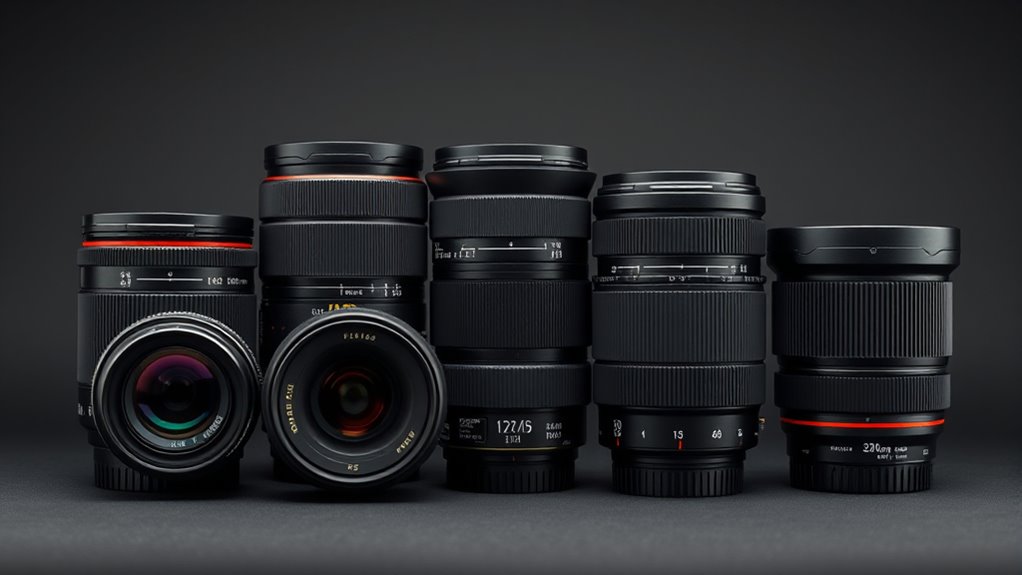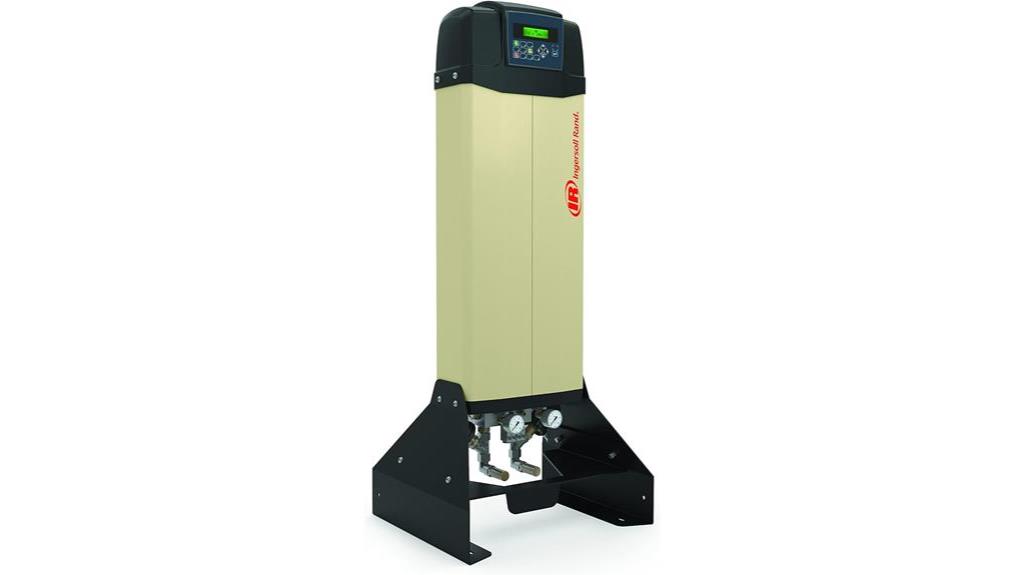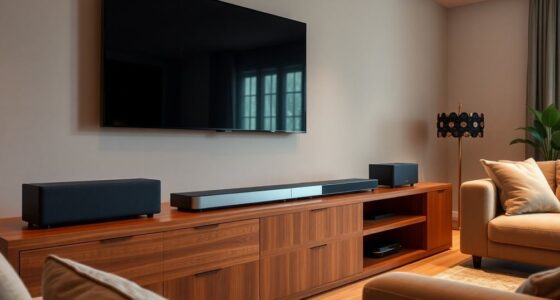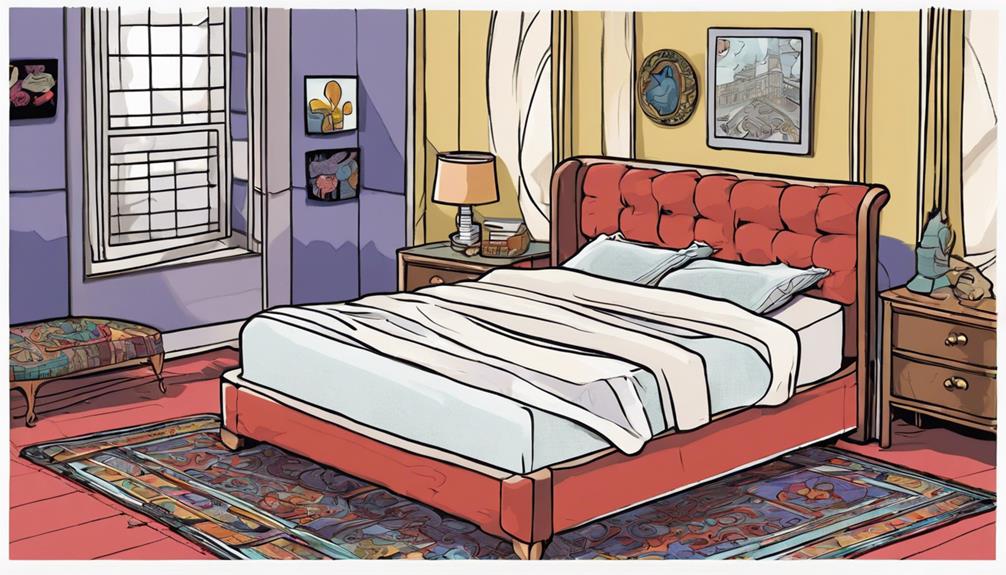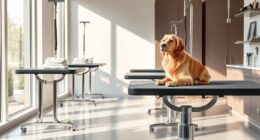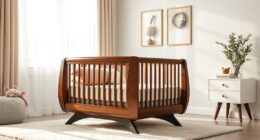If you’re aiming for stunning professional shots in 2025, I recommend exploring top lenses like the Canon EF 50mm f/1.8 STM, Nikon 55-300mm VR, and Sigma 150-600mm for versatile shooting. Each offers excellent sharpness, fast focus, and reliability across different styles, from portraits to wildlife. To make the best choice, you’ll want to take into account optical quality, autofocus speed, and build durability. Keep going, and you’ll discover all the essential details to elevate your photography game.
Key Takeaways
- Highlights of top premium DSLR lenses for professional photography in 2025, including prime, zoom, portrait, and macro options.
- Detailed features, optical qualities, and performance attributes of each lens for stunning image results.
- Maintenance and care tips with recommended cleaning equipment to preserve lens quality and longevity.
- Compatibility insights for various DSLR mounts and accessories to enhance creative versatility.
- Guidance on selecting lenses based on optical performance, build quality, and intended photographic applications.
Canon EF 50mm f/1.8 STM Lens
Looking for an affordable yet high-quality lens that delivers professional results? The Canon EF 50mm f/1.8 STM is perfect for that. It’s compact, lightweight, and versatile, making it ideal for portraits, street, and low-light photography. Its wide f/1.8 aperture gathers plenty of light, ensuring sharp images even in dim conditions. Thanks to the STM motor, autofocus is smooth and quiet, great for videos and quick shots. Its solid build and excellent image quality make it a reliable choice for both beginners and pros. At around $125, it’s an unbeatable value that enhances your kit with stunning bokeh and sharp detail.
Best For: hobbyists, beginners, and professionals seeking an affordable, high-quality prime lens for portraits, low-light, and street photography.
Pros:
- Excellent image sharpness and color fidelity, even when shot wide open
- Compact and lightweight design, ideal for portable use and travel
- Quiet, smooth autofocus with STM technology, perfect for video recording
Cons:
- Fixed focal length limits versatility compared to zoom lenses
- No weather sealing, making it less suitable for harsh outdoor conditions
- Slightly limited maximum magnification, less ideal for close-up macro work
Nikon 55-300mm f/4.5-5.6G ED VR Zoom Lens for Nikon DSLR Cameras
If you’re a photographer seeking versatile telephoto zoom capabilities without breaking the bank, the Nikon 55-300mm f/4.5-5.6G ED VR lens is an excellent choice. It offers a 55-300mm focal range, perfect for wildlife, sports, and outdoor shots, with sharp image quality thanks to ED and HRI elements. The lens features Nikon’s Silent Wave Motor for quick autofocus and Vibration Reduction, enabling steady handheld shooting at full zoom. While its aperture limits low-light performance, its affordability, portability, and effective VR make it ideal for enthusiasts wanting extended reach without professional-level costs. Overall, this lens balances performance and value beautifully.
Best For: hobbyist photographers and outdoor enthusiasts seeking an affordable, versatile telephoto zoom lens for wildlife, sports, and general outdoor photography on Nikon DX DSLR cameras.
Pros:
- Excellent image quality with ED and HRI elements for sharp, vibrant photos
- Effective Vibration Reduction (VR) allows sharp handheld shots at full zoom
- Compact and lightweight design makes it portable and suitable for outdoor use
Cons:
- Narrow maximum aperture limits low-light performance and indoor shooting
- Autofocus may hunt or delay in low contrast or challenging lighting conditions
- Bulky for travel or casual day trips due to its size and weight
Canon EF 75-300mm f/4-5.6 III Telephoto Zoom Lens for Canon SLR Cameras
The Canon EF 75-300mm f/4-5.6 III Telephoto Zoom Lens is an excellent choice for beginner photographers and hobbyists seeking an affordable yet versatile telephoto lens. It offers a broad focal range from 75mm to 300mm, perfect for portraits, wildlife, and landscapes. While it lacks image stabilization and uses a slower autofocus motor, it’s lightweight and well-built, making it easy to handle. Its close focusing ability allows for detailed macro shots of small objects, especially with a 58mm close-up lens. Despite some sharpness and autofocus limitations at longer focal lengths, it delivers good image quality for casual photography and offers great value for the price.
Best For: beginner photographers, hobbyists, and budget-conscious shooters seeking an affordable telephoto lens for portraits, wildlife, and landscapes.
Pros:
- Affordable price point with decent build quality
- Versatile focal range suitable for various subjects
- Compact and lightweight, easy to handle and carry
Cons:
- Lack of image stabilization requires tripod or high ISO use
- Slower autofocus motor results in noisier and less quick focusing
- Reduced sharpness at 300mm and when cropping images
Altura Photo DSLR Camera and Electronics Cleaning Kit
For photographers who demand pristine clarity and ideal performance from their DSLR gear, the Altura Photo DSLR Camera and Electronics Cleaning Kit offers a reliable and extensive solution. This compact, lightweight kit includes essential tools like a 2oz spray lens cleaner, lens cleaning pen, air blower, microfiber cloths, and lens tissue paper, compatible with all camera brands and models. Its alcohol-free, odorless formula guarantees safe cleaning of delicate optics and electronics. Users report noticeable improvements in image sharpness, dust removal, and smudge elimination. Easy to carry and use on the go, this kit is a must-have for maintaining peak gear performance and ensuring stunning, clear photos.
Best For: photographers, optics enthusiasts, and firearm owners seeking a comprehensive, safe, and portable cleaning solution for their delicate gear and electronics.
Pros:
- Includes all essential cleaning tools in one compact, lightweight kit for easy on-the-go maintenance
- Alcohol-free, ammonia-free, odorless formula ensures safe cleaning on sensitive optics and electronics
- Users report noticeable improvements in image clarity, dust removal, and smudge elimination
Cons:
- Some users find the lens pen’s graphite tip may smudge over time and may need replacement
- Lacks a dedicated sensor cleaning tool or specialized case for storage
- Microfiber cloths, though effective, might wear out with frequent use and require replacement
EF 85mm f1.8 Portrait Lens for Canon DSLR Cameras
Designed specifically for Canon DSLR cameras with EF/EF-S mounts, the EF 85mm f1.8 Portrait Lens delivers exceptional image quality and sharpness across a wide range of models, making it a versatile choice for photographers seeking professional results. This fully manual lens offers precise focus control, perfect for artistic and technical mastery. Its 6 rounded aperture blades produce beautiful bokeh, while the hybrid aspherical lens and ultra multi-coating minimize aberrations and glare. The internal focus mechanism ensures fast, quiet operation. Ideal for portraiture and creative exploration, it encourages skill development and offers durable, stable performance across various shooting scenarios.
Best For: photographers seeking a professional manual focus lens for portraiture and artistic photography with precise control and high-quality results.
Pros:
- Exceptional image sharpness and smooth bokeh thanks to 6 rounded aperture blades
- Durable construction with hybrid aspherical lens and ultra multi-coating for reduced aberrations and glare
- Fast, quiet internal focus mechanism suitable for various shooting scenarios
Cons:
- Fully manual focus requires practice and may be challenging for quick shooting situations
- No electronic contacts, so automatic exposure adjustments are not supported directly
- Limited to Canon DSLR cameras with EF/EF-S mounts, reducing compatibility with mirrorless systems
Nikon AF-S FX NIKKOR 50mm f/1.8G Lens for Nikon DSLR Cameras
If you’re seeking a versatile lens that delivers sharp images in various shooting conditions, the Nikon AF-S FX NIKKOR 50mm f/1.8G is an excellent choice for Nikon DSLR photographers. Its fast f/1.8 aperture ensures great low-light performance and beautiful background blur. The lens features a newly developed optical system with an aspherical element, providing edge-to-edge sharpness across FX and DX formats. Compact and lightweight, it’s perfect for everyday shooting and travel. Autofocus with Silent Wave Motor is quick and silent, making it ideal for candid shots. With a 58mm filter thread, it’s easy to customize with your favorite filters.
Best For: photographers seeking a compact, versatile prime lens with excellent low-light performance and sharp image quality for everyday and travel photography.
Pros:
- Fast f/1.8 aperture for superior low-light shooting and beautiful background blur
- Edge-to-edge sharpness across FX and DX formats due to advanced optical design
- Compact, lightweight construction makes it highly portable and easy to carry
Cons:
- Fixed focal length of 50mm limits zoom flexibility
- No optical stabilization feature included
- Slightly more expensive than basic kit lenses, which may be a consideration for budget-conscious buyers
Meike 85mm F1.8 Auto Focus Nikon F Mount Portrait Lens
The Meike 85mm F1.8 Auto Focus Nikon F Mount Portrait Lens stands out as an affordable yet capable option for photographers seeking sharp, stunning portraits. Designed for Nikon F mount DSLRs, it works well with full-frame and APS-C cameras, offering a versatile 127.5mm equivalent focal length on crop sensors. The lens features a wide f/1.8 aperture and nine blades, creating beautiful bokeh and excellent background blur. While autofocus can be noisy and occasionally slow, manual focus is precise and smooth. Weighing just over a pound, it’s lightweight and portable, making it ideal for handheld shooting. Overall, it’s a budget-friendly choice that delivers impressive image quality for portraiture.
Best For: amateur and budget-conscious photographers seeking a versatile, sharp portrait lens for Nikon DSLR cameras.
Pros:
- Affordable price point offering good value for portrait and landscape photography
- Produces beautiful bokeh with a wide f/1.8 aperture and nine blades
- Lightweight and portable, suitable for handheld shooting and travel
Cons:
- Autofocus can be noisy, slow, or unreliable, especially during video recording
- Some optical issues like chromatic aberration and flare under certain conditions
- Build quality may be inconsistent, with reports of rough paint and mechanical noise
Altura Photo 58MM Wide Angle Lens with Macro for DSLR Cameras
Looking to capture expansive wide-angle shots or close-up details with a single lens? The Altura Photo 58MM Wide Angle Lens with Macro makes this easy. It attaches directly to your 58MM filter thread, broadening your camera’s field of view for stunning landscape or architectural shots. The detachable macro feature lets you explore high-resolution close-ups of tiny objects, perfect for intricate details. Compatible with popular DSLR models from Canon, Nikon, Olympus, Lumix, and Fujifilm, it’s versatile and straightforward to use. Just screw it onto your lens, and you’re ready to expand your creative possibilities, whether shooting wide scenes or macro subjects.
Best For: photographers seeking to expand their creative options with wide-angle and macro capabilities on 58MM lens cameras, including DSLR and mirrorless models.
Pros:
- Easy to attach and remove, compatible with a variety of 58MM lenses
- Combines wide-angle and macro functions in one versatile accessory
- Enhances image quality for landscape, architecture, and close-up shots
Cons:
- Only compatible with lenses that have a 58MM thread size
- May introduce slight distortion or vignetting at the edges in wide-angle mode
- Requires verification of lens thread size before purchase to ensure compatibility
EF/EF-S 420-800mm F8.3 Telephoto Zoom Lens for Canon DSLR Cameras
For professional photographers seeking exceptional long-distance reach, the EF/EF-S 420-800mm F8.3 Telephoto Zoom Lens stands out as a budget-friendly manual focus option. Designed for Canon EOS DSLR cameras, it offers full-frame zoom from 420mm to 800mm, ideal for wildlife, birds, and distant landscapes. Its fully manual focus requires patience but delivers sharp images with background bokeh, especially at narrower apertures. While lacking electronic controls, it supports filters and includes an adapter ring. This lens challenges users to refine their focusing skills and offers a cost-effective way to explore long-distance photography with creative control.
Best For: experienced photographers seeking an affordable, manual-focus telephoto lens for long-distance wildlife, bird, and landscape photography with full creative control.
Pros:
- Budget-friendly price point making long-distance photography accessible
- Full-frame zoom capability from 420mm to 800mm for versatile shooting options
- Enhances photographic skills through manual focus and aperture control
Cons:
- Manual focus requires patience and practice, not suitable for quick shots
- No electronic autofocus or exposure controls, limiting ease of use in certain situations
- Potential fit issues with camera mounts due to manufacturing spacing needs adjustment
Nikon AF-S DX NIKKOR 55-300mm Lens for Nikon DSLR Cameras
If you’re seeking a versatile telephoto zoom lens capable of capturing distant subjects with sharp detail, the Nikon AF-S DX NIKKOR 55-300mm is an excellent choice for Nikon DSLR users. This factory-refurbished lens offers a 5.5x zoom range, ideal for wildlife, sports, and travel photography. It features Nikon’s Silent Wave Motor for fast, quiet autofocus, and Nikon VR II stabilization to ensure sharp images even handheld at slower shutter speeds. With ED and HRI elements, it minimizes chromatic aberration and boosts contrast. Weighing just 0.32 ounces, it’s compact and lightweight, includes all original accessories, and comes with a 90-day warranty.
Best For: photographers seeking a versatile telephoto zoom lens for wildlife, sports, and travel photography using Nikon DSLR cameras.
Pros:
- Fast, quiet autofocus with Nikon’s Silent Wave Motor (SWM) for precise shooting
- Effective image stabilization (VR II) for sharp handheld photos at slower shutter speeds
- High-quality optical elements like ED and HRI to reduce chromatic aberration and increase contrast
Cons:
- Slightly heavy and bulky compared to other compact lenses
- Potential for internal dust or smudges, especially in refurbished units, which may affect image quality over time
- Corners may darken at maximum zoom and autofocus may hunt in low-light conditions
Nikon 35mm f/1.8G AF-S DX Lens for Nikon DSLR Cameras (Renewed)
The Nikon 35mm f/1.8G AF-S DX Lens for Nikon DSLR Cameras (Renewed) stands out as an excellent choice for photographers seeking high-quality images on a budget. Its compact, lightweight design combines affordability with impressive performance, featuring a silent autofocus motor, a rounded 7-blade aperture for natural bokeh, and Nikon’s Super Integrated Coating to reduce flare and enhance color consistency. Ideal for indoor, low-light, and portrait photography, it performs similarly to a 50mm lens on crop sensors. While autofocus is slightly slower than newer models, users praise its sharpness, reliability, and suitability for beginners and hobbyists alike.
Best For: hobbyists and beginner photographers seeking an affordable, high-quality prime lens for portrait, indoor, and low-light photography with Nikon DSLR cameras.
Pros:
- Compact, lightweight, and easy to handle for extended shooting sessions
- Sharp center images with good autofocus performance and natural bokeh
- Durable construction with moisture seals and Nikon’s Super Integrated Coating
Cons:
- Autofocus slightly slower and noisier compared to newer AF-P models
- Cannot use screw-on filters due to threading limitations
- Fixed focal length requires more movement and planning compared to zoom lenses
Meike 85mm F1.8 Portrait Lens for Canon EF Cameras
Photographers seeking exceptional portrait shots on a budget will appreciate the Meike 85mm F1.8 lens for Canon EF cameras, as it combines impressive optical quality with affordability. Designed for Canon EOS EF mount cameras like the 5D Mark IV and 6D Mark II, this lens offers sharp images, smooth bokeh, and minimal chromatic aberration. Its wide f/1.8 aperture creates a shallow depth of field, perfect for portraits. Weighing just 420g and featuring a metal mount, it feels durable yet lightweight. Autofocus is generally quick and reliable, though it can be a bit noisy, especially in low light. Overall, a versatile, budget-friendly choice for portrait enthusiasts.
Best For: amateur and hobbyist portrait photographers seeking an affordable, lightweight lens with excellent bokeh and sharpness for Canon EF cameras.
Pros:
- Sharp image quality with smooth, round bokeh ideal for portraits
- Durable metal mount with lightweight design (420g) for comfortable handling
- Wide f/1.8 aperture allows for excellent low-light performance and shallow depth of field
Cons:
- Autofocus can be noisy, especially during video recording
- Autofocus speed may be slightly slower in very low light conditions
- Lacks image stabilization, which can affect video stability and handheld shooting
Nikon 55-200mm f/4-5.6G ED-IF AF-S DX VR Lens
Ideal for entry-level shooters and budget-conscious enthusiasts, the Nikon 55-200mm f/4-5.6G ED-IF AF-S DX VR Lens offers versatile zoom capabilities with impressive image stabilization. Weighing just 9 ounces, it’s lightweight and portable, making it perfect for outdoor photography, portraits, and sports. Its 55-200mm range and vibration reduction help capture sharp images even in challenging conditions. While autofocus can be loud and occasionally slow, many users appreciate its sharpness and value for the price. Compatible with a variety of Nikon DSLRs, it’s an excellent choice for those starting out or seeking an affordable telephoto option without sacrificing image quality.
Best For: entry-level photographers and budget-conscious enthusiasts seeking a versatile telephoto lens for portraits, outdoor, and sports photography.
Pros:
- Lightweight and portable at only 9 ounces, ideal for outdoor shooting and travel.
- Good image quality with sharpness and effective vibration reduction for stable shots.
- Compatible with a wide range of Nikon DSLR cameras, offering versatility for beginners.
Cons:
- Autofocus can be loud, slow, and less effective for fast-moving subjects.
- Image quality may diminish at the extreme zoom ranges, especially in less-than-ideal lighting.
- Sold renewed with bulk packaging, which may lack some retail accessories and presentation.
High-Power 420-1600mm f/8.3 Telephoto Zoom Lens for Sony DSLR Cameras
If you’re looking to capture distant subjects with exceptional detail, the High-Power 420-1600mm f/8.3 Telephoto Zoom Lens is a standout choice for Sony DSLR users. Designed for A-mount cameras, it offers a versatile zoom range perfect for wildlife, sports, landscapes, and celestial photography. With a focal length extending up to 1600mm using a teleconverter, it delivers crisp images at f/8.3, though manual focus can be tricky. Its plastic build makes it lightweight but requires careful handling. A tripod is highly recommended due to its size and weight. Overall, it’s a powerful option for serious photographers seeking long-range capabilities.
Best For: photographers using Sony A-mount DSLR cameras who want to capture distant wildlife, sports, landscapes, or celestial objects with high detail.
Pros:
- Long zoom range from 420mm to 1600mm allows for versatile distant photography.
- Produces crisp, detailed images at f/8.3 with manual focus control.
- Lightweight construction (1 pound) makes handling easier despite its size.
Cons:
- Manual focus operation can be challenging for some users.
- Constructed mainly with plastic components, which may be prone to damage or jamming.
- Compatibility issues reported, such as not fitting certain camera models like Canon EOS R8.
Sigma 150-600mm 5-6.3 Contemporary DG OS HSM Lens for Nikon
Looking for a versatile super-telephoto lens that delivers professional-grade images without weighing you down? The Sigma 150-600mm F5-6.3 Contemporary DG OS HSM for Nikon fits the bill perfectly. It’s Sigma’s first hyper-telephoto zoom in their Contemporary line, offering a lightweight, compact design at just 1930g. With a 150-600mm focal range, it’s ideal for wildlife, sports, and outdoor photography. The lens features a water- and oil-repellent coating, plus dust- and splash-proof durability, making it suitable for challenging environments. Compatibility with Sigma teleconverters adds flexibility, ensuring you can extend your reach without sacrificing image quality.
Best For: outdoor photographers, wildlife enthusiasts, and sports shooters seeking a lightweight, durable super-telephoto lens for capturing distant subjects with professional quality.
Pros:
- Lightweight and compact design (1930g) for easy handling and portability
- Water- and oil-repellent coating plus dust- and splash-proof construction for challenging conditions
- Compatible with Sigma teleconverters to extend focal length without compromising image quality
Cons:
- Fixed maximum aperture of F5-6.3 may limit low-light performance
- Heavy at 1930g, which might still be taxing for extended handheld use
- Limited to use with specific Sigma teleconverters; incompatible with other brands or unlisted models
Factors to Consider When Choosing Premium Professional DSLR Lenses
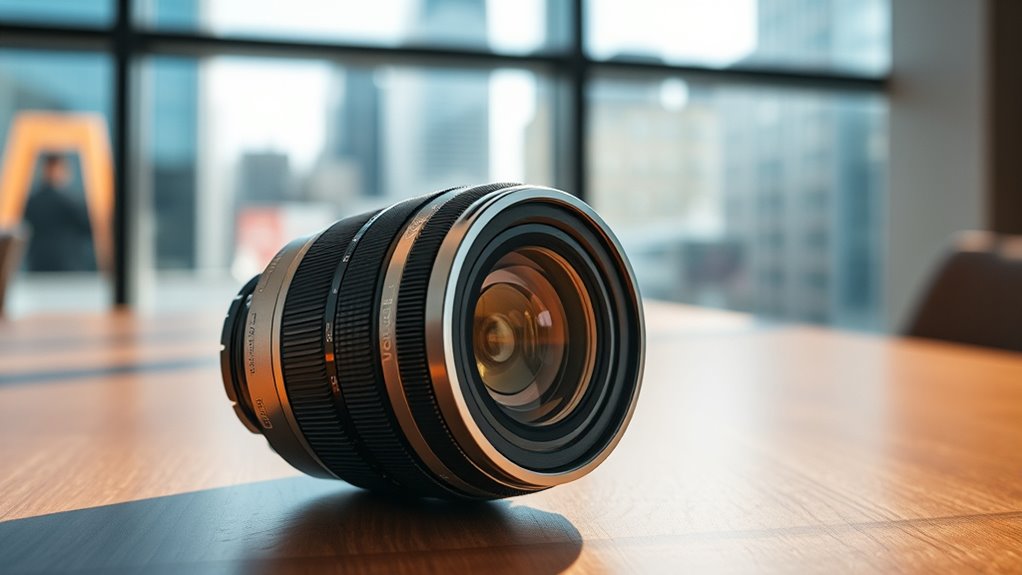
When selecting a premium professional DSLR lens, I focus on optical quality, autofocus accuracy, and build durability to guarantee reliable performance. I also consider aperture versatility for creative flexibility and compatibility with my camera system. These factors help me choose a lens that meets my needs and delivers stunning results.
Optical Quality Standards
Choosing a premium professional DSLR lens hinges on understanding its optical quality standards, which directly impact image clarity and fidelity. High-quality lenses incorporate advanced optical elements like aspherical, low-dispersion, and hybrid aspherical lenses to minimize distortions and aberrations. This ensures sharp, high-contrast images across the entire frame, even at wide apertures such as f/1.8 or f/2.8. Superior coatings like UMC, Nikon’s Super Integrated Coating, or multi-coating further reduce flare, ghosting, and reflections, boosting clarity. The optical design involves numerous elements and groups arranged strategically to optimize image quality and correct chromatic aberrations. Consistent performance across different shooting conditions guarantees accurate colors, contrast, and resolution. These standards are essential when selecting lenses that deliver professional-grade image quality.
Autofocus Precision
Autofocus precision in premium professional DSLR lenses hinges on several critical factors that directly affect how accurately and quickly your camera can lock onto subjects. First, the quality of the autofocus motor matters—USM or SWM motors typically deliver faster, more precise focusing. Internal focus (IF) mechanisms also improve speed and reduce focus breathing, which helps with subject tracking. Advanced lenses often include focus calibration or micro-adjustment features, allowing fine-tuning for specific camera bodies. The number and design of focus drive elements, like stepping motors and focus rings, influence focus accuracy across different lighting conditions. Additionally, the optical design, including elements such as aspherical or low-dispersion glass, minimizes aberrations that could compromise focus precision. All these factors combine to ensure sharp, reliable autofocus in demanding shooting scenarios.
Build Durability
The durability of a professional DSLR lens directly impacts its ability to perform reliably over time, especially in demanding shooting environments. High-quality materials like metal mounts and weather-sealed gaskets are essential, offering protection against dust, moisture, and environmental elements. Weather sealing is crucial for extending a lens’s lifespan in harsh conditions, ensuring consistent performance. Reinforced internal components and robust construction help withstand frequent handling and transportation, reducing the risk of mechanical failure. Using corrosion-resistant materials such as stainless steel or treated metals prevents deterioration, especially in humid or salty environments. Ultimately, a lens with superior build durability not only lasts longer but maintains optimal performance, making it a vital consideration for professionals who rely on their gear in diverse and challenging settings.
Aperture Versatility
Aperture versatility is a key factor in selecting a professional DSLR lens because it directly affects your ability to adapt to different shooting conditions. A wider maximum aperture, like f/1.4 or f/1.8, lets in more light, which is perfect for low-light environments and achieving stunning background blur. Fixed apertures such as f/2.8 throughout the zoom range provide consistent exposure and depth of field control, ideal for professional work. Variable apertures, like f/3.5-5.6, offer flexibility across focal lengths but may require adjustments for proper exposure at different zoom levels. Manual aperture control allows fine-tuning of depth of field and motion effects, giving you creative freedom. Overall, aperture versatility shapes your lens’s suitability for genres from portraiture to landscape and night photography.
Compatibility Range
Choosing the right professional DSLR lens involves more than just image quality and aperture features; compatibility is equally important. First, I always double-check the lens mount type—Canon EF/EF-S or Nikon F-mount—to ensure it fits my camera body. I also confirm that the lens supports my camera’s sensor format, whether full-frame or APS-C, to get the desired field of view and performance. Additionally, I verify that the lens has electronic contacts for autofocus, image stabilization, and aperture control compatible with my camera model. I also consider whether the focus mechanism, whether auto-focus or manual, works seamlessly with my camera’s autofocus system. Finally, I check if accessories like filters or teleconverters fit properly, maximizing the lens’s versatility.
Price and Value
Evaluating price and value involves more than just comparing sticker prices; I focus on how well a lens’s features and performance align with my photographic needs. Premium lenses typically range from $1,000 to over $3,000, reflecting their advanced optical quality and features. While higher prices often mean better glass, coatings, and stabilization, they don’t always suit every style. I consider how versatile, durable, and capable a lens is in enhancing image quality before committing. Investing in a lens with superior build and coatings can save money long-term by reducing repairs or replacements. Ultimately, I weigh the lens’s performance benefits against its cost to ensure I get the best worth for my photography style and goals.
Handling and Weight
Handling and weight are essential factors when selecting a premium DSLR lens, as they directly affect comfort and stability during shoots. Heavier lenses, often over 1.5 pounds, can cause fatigue during long sessions, making it harder to maintain steady shots. To manage this, a sturdy tripod or stabilizer is vital to support the weight and reduce camera shake. The size and weight of professional lenses also impact portability; compact designs are better for travel and spontaneous shoots. Longer, bulkier lenses require a firm grip and careful maneuvering, especially in dynamic environments. Choosing a lens that’s manageable in weight not only makes handling easier but also lessens strain on your camera mount and lowers the risk of accidental drops, ensuring safer, more comfortable shooting.
Frequently Asked Questions
How Do Lens Coatings Improve Image Quality in Premium DSLR Lenses?
Lens coatings improve image quality by reducing reflections and flare, which helps capture sharper, clearer images. They also enhance color accuracy and contrast, making photos more vibrant and true to life. I’ve found that high-quality coatings on premium DSLR lenses minimize ghosting and glare, especially in tricky lighting conditions. Overall, these coatings guarantee I get the best possible image quality, even in challenging environments.
What Are the Differences Between Image Stabilization Types in Professional Lenses?
You might think all image stabilization types are the same, but they’re not. Optical stabilization (IS) moves the lens elements themselves, providing smooth correction right in the lens. In-body stabilization (IBIS) shifts the camera sensor, offering flexibility across lenses. Each has pros and cons; I find optical stabilization better for fast-moving subjects, while IBIS shines in low light and handheld shots. Knowing the difference helps me choose the right lens for every shot.
How Does Lens Weather Sealing Impact Durability and Usability?
Weather sealing considerably boosts a lens’s durability and usability by protecting it from dust, moisture, and harsh weather conditions. When I shoot outdoors, I rely on sealed lenses to prevent damage and maintain performance in challenging environments. It allows me to focus on capturing great shots without worry. Overall, weather sealing is a valuable feature, especially for professional photographers who need reliable gear in any weather.
What Is the Significance of Aperture Blades in Professional Portrait Lenses?
Aperture blades are vital in professional portrait lenses because they control the shape and quality of the out-of-focus areas, known as bokeh. I love how well-designed blades create smooth, circular bokeh that adds a dreamy effect to portraits. They also allow me to achieve precise control over depth of field, helping me isolate my subject beautifully. Ultimately, the number and shape of aperture blades directly influence the lens’s artistic potential.
How Do Filter Compatibility and Front Element Size Affect Lens Performance?
Did you know that a lens with a 77mm front element is more versatile for filters? Filter compatibility and front element size directly impact performance—larger elements allow for better light control and creative filters, but can make the lens bulkier. I always check filter sizes before buying, so I can use my favorite ND or polarizing filters without issues, ensuring sharp, high-quality images every time.
Conclusion
Choosing the right premium DSLR lens can transform your photography, but the true magic lies in discovering which one unleashes your unique creative vision. Will it be a versatile zoom, a stunning prime, or a specialized telephoto? The secret is in your hands—dive deeper, experiment, and find that perfect lens that elevates your craft to awe-inspiring heights. The journey to stunning images begins now—are you ready to uncover what’s next?
